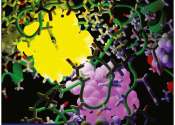Previous theory on how electrons move within protein nanocrystals might not apply in every case
Researchers believe that understanding how electrons move within small, natural systems could power a more sustainable future for our energy grid.

Researchers believe that understanding how electrons move within small, natural systems could power a more sustainable future for our energy grid.
Analytical Chemistry
Apr 23, 2024
0
129

Electronic devices are getting smaller and smaller. Early computers filled entire rooms. Today you can hold one in the palm of your hand. Now the field of molecular electronics is taking miniaturization to the next level. ...
Materials Science
Jan 17, 2018
0
6

The Latest on the Nobel Chemistry Prize (all times local):
Other
Oct 4, 2017
0
3

Researchers at the University of Calgary found that amino acid residues form a type of barrier to help in the process of electron transfer between proteins.
Biochemistry
Jun 14, 2010
1
0

The MIPT Center for Molecular Electronics (CME) has developed and tested a seismic station for hydrocarbon exploration. The new device has unparalleled bandwidth, enabling it to reveal the structure of underground reservoirs ...
Earth Sciences
Oct 5, 2017
0
8

Abscisic acid (ABA) is a key plant hormone produced in response to abiotic stress such as drought and salt. It is mainly synthesized in roots and vascular tissues and transported to specific sites to exert physiological functions. ...
Plants & Animals
Sep 5, 2023
0
1

Molybdenum disulfide (MoS2) is a highly versatile material that can function, for example, as a gas sensor or as a photocatalyst in green hydrogen production. Although the understanding of a material usually starts from investigating ...
Nanomaterials
Nov 1, 2023
0
1

Silver, gold and copper nanowires are leading contenders for next-generation nanoscale devices, however greater understanding of how they work and improved production methods are needed before they can be widely used, explains ...
Nanomaterials
Mar 26, 2019
0
9

A research team led by Prof. Chen Yuxing and Prof. Zhou Cong from the University of Science and Technology of China (USTC) of the Chinese Academy of Sciences (CAS) recently utilized single-particle cryogenic electron microscopy ...
Cell & Microbiology
Jul 28, 2023
0
63

Our excessive consumption of fossil fuels is responsible for some of the major societal challenges we are facing, from climate change to pollution. Hydrogen is considered a green alternative to fossil fuels, and alkaline ...
Analytical Chemistry
Sep 26, 2022
0
5